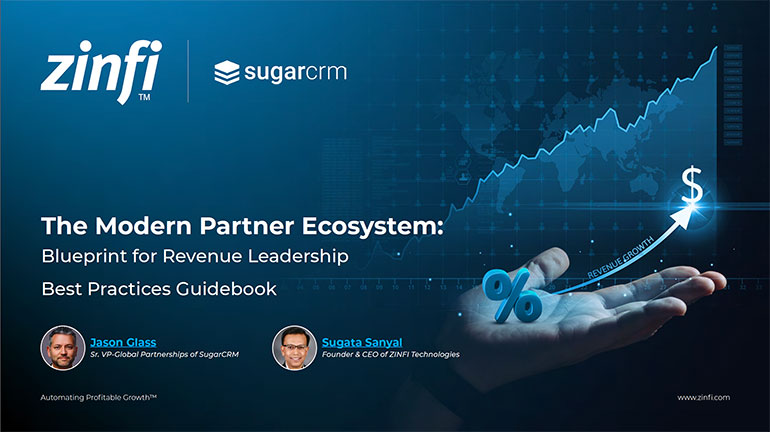Best Practices Articles

Key Channel Sales Metrics You Must Track
“What you measure is what you get” is a great business mantra. And when it comes to sales, it becomes much more than that: it’s a practice that drives the future sustainability and growth of a company. To make an impact, metrics need to be applied across multiple business areas by deploying channel marketing automation, of course. For example, if you are managing sales operations through a channel partner network, you need to look beyond simple sales out. Failing to track critical channel sales metrics listed below could lead you down a blind alley where you end up not knowing what’s going to hit you next.
Channel success comes as a result of setting up realistic, if ambitious expectations with your channel sales force and partner network, but these mean nothing without the ability to monitor a core set of performance metrics. Output metrics are driven by a set of processes, programs and people directly linked to their related input metrics. These will provide you with essential insights into what is actually happening in your channel; however, you need to correlate input metrics to output metrics in order to understand the impact of each of these metrics on overall results. A best of breed channel marketing automation platform should enable you to track the metrics described below, as well as to use dynamic dashboard capabilities to run multiple analytics that will enable you to fine-tune your channel program for optimum results.
Here is a brief overview of the 15 core input and output metrics, and how you can use the data to drive profitable sales growth.
- Total and Average Revenue Per Partner – This is almost equivalent to the commonly used revenue-per-employee metric. When you perform this analysis, you will see that productivity varies greatly across the top, medium and entry level partner tiers. Tracking revenues on a dynamic basis is a critical first step towards improving sales engagement.
- Revenue Mix Analysis – This is predominantly undertaken by product line, geography and territory. Most companies use this data primarily for market share analysis, but if you directly correlate the data with other partner input and output metrics you can draw a more complete analysis of partner engagement and potential.
- Percent of Revenue Growth Rate of Partner Tiers – This is a high priority output metric that you need to track in order to see how your channel sales partners are growing across your different product lines. The variables include partner level, product type and geographical location. The resulting data enables you to make strategic resource changes to drive better results.
- Gross Profit Per Tier - At the end of the day it is about more than revenue alone: the key lies in the absolute profit that you are able to generate via the channel sales force. Calculations of partner profitability vary greatly depending on how you are able to track your internal costs. These might include technical support, channel sales, channel marketing, programs, special events and more. You also need clarity about the relative levels of profit generated by the different partner tiers, e.g. how much is generated by your top 10%, 11-25%, 26-50% and so on, and what your relative level of investment was for each tier.
- Percent of Year over Year Increase In Channel Revenue and Productivity – This is your ultimate measure of progress on a year over year basis. In order to do this you will need to be able to calculate your revenue growth, which all companies do, but beyond this you will need to factor in the detailed cost infrastructure required to support your channel - which at times is a bit harder to achieve due to product and process complexities. However, efforts spent in this area are critical to drive a much more finely tuned approach towards metrics-driven channel sales management.
- Percent of Active Resellers - Most companies, whether they have a broad or a narrowly focused channel sales model, have to deal with wide variations in sales per partner. It is important to be able to identify what portion of your channel partners are selling consistently quarter over quarter, for the past four quarters, as this will drive the next stages of program activity as you figure out how to increase sales out from the lower-performing partners.
- Channel Attrition Rate (% Drop Out Rate of Active Resellers) - If you have a channel partner network of a few hundred or more, the chances are that on an annual basis a portion of your network will stop selling your products and services. Tracking this attrition rate actively and analyzing who is leaving and why is critical to make sure keep a handle on the situation.
- Percentage of Reseller Base Generating Largest Percentage of Revenue - Why is this important? Well, simply when you are selling through a broad channel, as most companies do, no matter how big your company is, the chances are you have limited resources and bandwidth. You will need to maximize return on channel sales resources, so knowing where it will be most profitable to focus is critical.
- Percent of Renewal Rate on Maintenance and Service Contracts - Most companies selling through the channel today derive substantial revenues from add-on and renewal sales. While the channel remains a the primary way of fulfilling existing demand, partners tend to lack resources to monitor systematic contract renewals like subscription contracts, warranties or services. Therefore, your ability to track renewals and drive actions based on detailed data has the potential to greatly improve your top and bottom line. It is always easier to grow existing customers rather than establish new ones.
- End User Satisfaction With Your Reseller Base - As the level of complexity of technology products and deployments rises, it has become even more essential to ensure your partner network is fully trained and certified. At the end of the day it is the quality of technical engagement between your resellers and their end-users that drives customer satisfaction. It follows that measuring end user satisfaction on a regular basis is critical to understanding where you need to invest to overcome partner skills gaps and grow your channel’s strengths.
- Partner Satisfaction - Along with end-user satisfaction analysis, you also need to know where your partners stand in relation to your products, services and support. Your competitors are always on the move, so it’s never safe to assume your partner base will feel the same from one quarter to the next. This understanding is essential to your ability to focus channel marketing and sales resources efficiently in order to drive optimum results. Even a simple integrated survey tool will help you capture your partners’ experiences in a systematic way.
- Partner Certification Rate - This is a critical metric that allows you to measure the depth and breadth of your channel’s capabilities. Organizations that use a Learning Management System (LMS) tend to have a more systematic, and therefore easier way to track progress in this area, but even without a fully functional LMS you should be able to monitor certification rates using your Partner Relationship Management platform.
- Return on Market Development Funds- This is a critical metric allowing you not only to eliminate wasted investment and focus on high-producing programs, but also to strategically align your marketing activities to and through the channel. Most companies that have a Partner Relationship Management platform combined with Market Development Funds (MDF) tracking functionality can easily monitor expenditure versus results, and drive improvements both globally and locally.
- Graduation Rates (from bottom tier to mid tier, mid tier to top tier, etc.) - The channel is a dynamic environment. All the time, new partners are joining and a few partners are leaving, but you also have partners moving up from entry level to mid-tier to the top tier of your channel program. Making sure you know how and why this is happening, and remaining engaged in managing this movement proactively – as opposed to being a passive observer - is critical to maintaining a profitable channel growth model.
- Total Channel Marketing and Sales Cost to Channel Revenue Ratio - This is primarily a measurement of efficiency and return on investment. In most organizations, the total cost of sales - including channel marketing and other investments - need to be less than 25-30% of revenue for a run rate business to create a profitable growth model. However, if you are trying to build out your channel, this ratio is likely to be substantially higher during the earlier stages.
If you are using a basic CRM platform you may very well be able to track some of these metrics, but CRM systems do not provide the same essential functionality as a purpose built Partner Relationship Management (PRM) platform, which is are designed to give you the end-to-end visibility necessary to track and manage all aspects of a channel management program. As part of your forward planning to build out a metrics-based high performing channel, it is advisable take a look at the rapidly evolving PRM tools that are now available in the market.
When it comes to channel sales metrics, we see various levels of maturity across our customer base worldwide. One constant however is, those organizations that spend more time understanding channel sales metrics are more focused, probably undertake fewer initiatives, but generally drive more growth per initiative. This is a qualitative observation across more than fifty of ZINFI’s global clients. We would love to hear from you about what metrics you are tracking and how they are driving profitable growth for you.
Best Practices Guidebook
 The Channel Sales Playbook: Skills, Strategy, and Growth
The Channel Sales Playbook: Skills, Strategy, and GrowthDownload for FREE
 Blueprints for Vertical Success Best Practices
Blueprints for Vertical Success Best PracticesDownload for FREE
 The Future of Partner Enablement: From Enablement Gaps to Global Advantage
The Future of Partner Enablement: From Enablement Gaps to Global AdvantageDownload for FREE
 Reimagine Sales Development. Build a Smarter Prospecting Engine
Reimagine Sales Development. Build a Smarter Prospecting EngineDownload for FREE
 The Zero Trust Imperative: Fortifying Enterprise Security Against AI-Driven Threats
The Zero Trust Imperative: Fortifying Enterprise Security Against AI-Driven ThreatsDownload for FREE
 PartnerOps Excellence: The Definitive Guide to Scalable SaaS Ecosystems
PartnerOps Excellence: The Definitive Guide to Scalable SaaS EcosystemsDownload for FREE
 The Modern Partner Ecosystem Best Practices
The Modern Partner Ecosystem Best PracticesDownload for FREE
 Partner Marketing Reimagined: Strategies for Agile, Insight-Led Growth
Partner Marketing Reimagined: Strategies for Agile, Insight-Led GrowthDownload for FREE
 Scaling with PartnerOps Best Pratices
Scaling with PartnerOps Best PraticesDownload for FREE
 Leading with Partner Programs Best Pratices
Leading with Partner Programs Best PraticesDownload for FREE
 The Partner-First Blueprint: Scaling Trust, Intelligence, and Ecosystem Growth
The Partner-First Blueprint: Scaling Trust, Intelligence, and Ecosystem GrowthDownload for FREE
 Unlock Scalable Growth with The Partner Marketing Growth Blueprint
Unlock Scalable Growth with The Partner Marketing Growth BlueprintDownload for FREE
 From TikTok to LinkedIn: Social Selling Across the Generational Divide
From TikTok to LinkedIn: Social Selling Across the Generational DivideDownload for FREE
 Scaling Partner Ecosystems: From Enablement to Intelligence
Scaling Partner Ecosystems: From Enablement to IntelligenceDownload for FREE
 The Ultimate Guide to Partner Marketing Success Best Practices
The Ultimate Guide to Partner Marketing Success Best PracticesDownload for FREE
 How to Start and Scale Partner Ecosystems Best Practices
How to Start and Scale Partner Ecosystems Best PracticesDownload for FREE
 The Evolution of PartnerOps: Past, Present & Future Best Practices
The Evolution of PartnerOps: Past, Present & Future Best PracticesDownload for FREE







